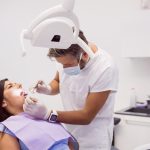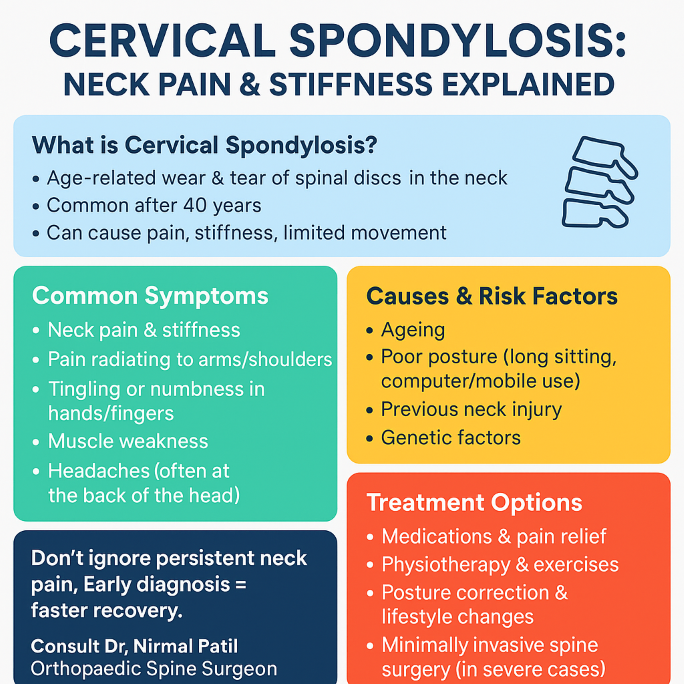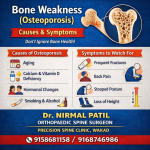Neck pain and stiffness are among the most common health complaints in today’s fast-paced lifestyle. While occasional discomfort may arise from poor posture, long working hours, or stress, persistent and recurring neck pain could be a sign of a deeper underlying issue—Cervical Spondylosis. Often referred to as age-related “wear and tear” of the cervical spine, this condition can significantly affect daily life if not addressed early.
In this blog, we will explore cervical spondylosis in detail—its causes, symptoms, diagnosis, treatment options, and preventive measures.
What is Cervical Spondylosis?
Cervical spondylosis is a degenerative condition that affects the bones (vertebrae), discs, and joints of the cervical spine (the neck region of the backbone). With aging, the spinal discs lose their elasticity, become thinner, and may form bone spurs. These changes can compress nearby nerves, leading to pain, stiffness, and neurological symptoms.
Although cervical spondylosis is most common in people over the age of 40, it is increasingly being diagnosed in younger individuals due to sedentary lifestyles, prolonged screen use, and poor posture.
Causes and Risk Factors
Several factors contribute to the development of cervical spondylosis:
- Ageing:
- Natural wear and tear of spinal discs and joints occur with advancing age.
- Most individuals above 60 show some degree of cervical spondylosis on X-rays.
- Poor Posture:
- Slouching, bending the neck forward for long hours, and improper workstation ergonomics accelerate degeneration.
- “Tech neck” caused by excessive smartphone or laptop use is a rising cause among young adults.
- Genetics:
- A family history of spine problems increases the risk.
- Injury or Trauma:
- Previous neck injuries can weaken the cervical spine and hasten spondylosis.
- Occupation:
- Jobs that involve repetitive neck movements, heavy lifting, or prolonged sitting may predispose individuals to early wear and tear.
Common Symptoms of Cervical Spondylosis
The severity of symptoms varies from person to person. Some may have mild stiffness, while others experience significant nerve-related issues.
- Neck Pain & Stiffness: Persistent pain, worse after activity or prolonged sitting.
- Headaches: Often starting at the back of the head.
- Pain Radiating to Shoulders and Arms: Due to nerve root compression.
- Tingling or Numbness: Common in arms, hands, or fingers.
- Muscle Weakness: Difficulty lifting objects or reduced grip strength.
- Grinding or Popping Sounds: When moving the neck.
- Reduced Range of Motion: Difficulty turning or bending the neck.
In severe cases, spinal cord compression can lead to loss of coordination, balance issues, and bladder/bowel dysfunction—conditions that require immediate medical attention.
Diagnosis
A spine specialist diagnoses cervical spondylosis through:
- Medical History & Physical Examination: Evaluating symptoms, lifestyle habits, and neck mobility.
- Imaging Tests:
- X-ray: To detect bone spurs and alignment changes.
- MRI (Magnetic Resonance Imaging): To visualize disc herniation, nerve compression, or spinal cord involvement.
- CT Scan: For detailed bone imaging.
- Neurological Tests: Checking reflexes, strength, and sensory functions.
Treatment Options for Cervical Spondylosis
Treatment depends on the severity of the condition and the impact on daily life. Most cases can be managed without surgery.
1. Non-Surgical Treatments
- Medications: Pain relievers, anti-inflammatory drugs, and muscle relaxants to ease discomfort.
- Physiotherapy:
- Strengthening and stretching exercises for neck and shoulder muscles.
- Posture correction techniques.
- Cervical traction (under professional guidance) to relieve pressure on nerves.
- Lifestyle Modifications:
- Ergonomic workspace setup.
- Avoiding prolonged screen use without breaks.
- Maintaining a healthy weight.
- Heat or Ice Therapy: To reduce muscle spasm and pain.
2. Minimally Invasive Procedures
For individuals not responding to conservative measures, pain specialists may recommend:
- Epidural Steroid Injections: To reduce inflammation around nerve roots.
- Radiofrequency Ablation (RFA): Targeting pain-carrying nerves for longer relief.
3. Surgical Treatment
Surgery is considered when:
- Severe nerve compression causes weakness, numbness, or loss of bladder/bowel control.
- Pain persists despite months of non-surgical treatment.
- Spinal cord compression (cervical myelopathy) is detected.
Surgical Options Include:
- Discectomy: Removal of herniated or damaged disc.
- Laminectomy: Removing part of vertebra to relieve pressure.
- Spinal Fusion: Joining two or more vertebrae to stabilize the spine.
- Minimally Invasive/Endoscopic Spine Surgery: Modern techniques with smaller cuts, quicker recovery, and less post-operative pain.
Preventing Cervical Spondylosis
While aging cannot be stopped, healthy habits can significantly reduce the risk of cervical spondylosis:
- Practice Good Posture: Keep your back straight and shoulders relaxed.
- Ergonomic Work Setup: Monitor at eye level, supportive chair, and frequent breaks from sitting.
- Exercise Regularly: Strengthen neck, shoulder, and back muscles.
- Avoid Prolonged Screen Use: Follow the 20-20-20 rule—every 20 minutes, look 20 feet away for 20 seconds.
- Sleep Support: Use a supportive pillow that keeps the neck aligned with the spine.
- Stay Active & Maintain Weight: Extra weight adds strain on the spine.
Living with Cervical Spondylosis
Many people live normal lives with cervical spondylosis by adopting the right management plan. With regular physiotherapy, posture awareness, and medical guidance, symptoms can be controlled effectively. Early consultation with a spine specialist ensures timely intervention and prevents complications.
When to See a Spine Surgeon
Seek immediate medical advice if you experience:
- Severe, persistent neck pain.
- Weakness or numbness in arms or legs.
- Loss of bladder or bowel control.
- Difficulty walking or balancing.
These could be signs of spinal cord compression, requiring urgent treatment.
Conclusion
Cervical spondylosis is a common but manageable condition. While aging plays a major role, modern lifestyle factors like poor posture and excessive screen use have made it a growing concern among younger individuals as well. The good news is—with timely diagnosis, physiotherapy, lifestyle changes, and advanced surgical options when necessary—patients can achieve lasting relief and return to a pain-free life.
If you or your loved ones are experiencing chronic neck pain, consult an experienced spine specialist for evaluation and personalized care.













